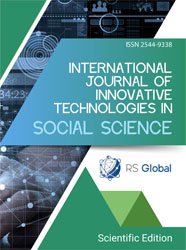HOW TO EFFECTIVELY PROTECT THE HUMAN BODY FROM THE HARMFUL INFLUENCE OF XENOESTROGENS AND OTHER ENDOCRINE DISRUPTORS: PREVENTIVE AND THERAPEUTIC PERSPECTIVES
Abstract
Xenoestrogens constitute a group of endocrine-disrupting chemicals that, by mimicking or interfering with the actions of endogenous estrogens, can affect hormonal balance and reproductive function. Due to their widespread presence in the environment—including plastics, cosmetics, food, and everyday consumer products—complete avoidance of exposure is virtually impossible. However, studies indicate that proper education, lifestyle modifications, and dietary interventions can significantly reduce exposure to these compounds and the associated health risks. This article investigates various strategies for the prevention of xenoestrogen and other endocrine disruptors exposure, the reduction of existing body burdens of these chemicals. The effectiveness of dietary and behavioral interventions is discussed, such as avoiding canned foods and plastic products, as well as using personal care products free from phthalates, parabens, triclosan, and benzophenone-3, all of which have been shown to markedly decrease urinary levels of xenoestrogens and other endocrine disruptors. Therapeutic interventions are also presented, including the use of selected supplements and pharmacological agents such as Chlorella pyrenoidosa, cholestyramine, olestra, coenzyme Q10, melatonin, and multi-strain probiotics, which have demonstrated beneficial effects in reducing the concentrations of endocrine-active compounds and mitigating their toxic effects. These findings underscore the critical role of multifaceted approaches, combining preventative behavioral changes with targeted substance interventions, to effectively mitigate exposure and safeguard public health from ubiquitous endocrine-disrupting chemicals (EDCs).
References
Sathyanarayana, S., Alcedo, G., Saelens, B. E., Zhou, C., Dills, R. L., Yu, J., & Lanphear, B. (2013). Unexpected results in a randomized dietary trial to reduce phthalate and bisphenol A exposures. Journal of Exposure Science & Environmental Epidemiology, 23(4), 378–384. https://doi.org/10.1038/jes.2013.9
Dairkee, S. H., Moore, D. H., Luciani, M. G., Anderle, N., Gerona, R., Ky, K., Torres, S. M., Marshall, P. V., & Goodson III, W. H. (2023). Reduction of daily-use parabens and phthalates reverses accumulation of cancer-associated phenotypes within disease-free breast tissue of study subjects. Chemosphere, 322, Article 138014. https://doi.org/10.1016/j.chemosphere.2023.138014
Hagobian, T., Smouse, A., Streeter, M., Wurst, C., Schaffner, A., & Phelan, S. (2017). Randomized intervention trial to decrease bisphenol A urine concentrations in women: Pilot study. Journal of Women’s Health, 26(2), 128–132. https://doi.org/10.1089/jwh.2016.5746
Kim, J. H., Kwak, J. M., & Kang, H. (2021). Web-based behavioral intervention to reduce exposure to phthalate metabolites, bisphenol A, triclosan, and parabens in mothers with young children: A randomized controlled trial. International Journal of Hygiene and Environmental Health, 236, Article 113798. https://doi.org/10.1016/j.ijheh.2021.113798
Nakano, S., Takekoshi, H., & Nakano, M. (2007). Chlorella (Chlorella pyrenoidosa) supplementation decreases dioxin and increases immunoglobulin A concentrations in breast milk. Journal of Medicinal Food, 10(1), 134–142. https://doi.org/10.1089/jmf.2006.023
Sakurai, K., Fukata, H., Todaka, E., Saito, Y., Bujo, H., & Mori, C. (2006). Colestimide reduces blood polychlorinated biphenyl (PCB) levels. Internal Medicine, 45(5), 327–328. https://doi.org/10.2169/internalmedicine.45.1478
Lin, T.-C., Wang, K.-H., Chuang, K.-H., Kao, A.-P., & Kuo, T.-C. (2025). Melatonin reverses bisphenol A–induced toxicity in granulosa cells: Restoration of FSHR and connexin 43 expression. Taiwanese Journal of Obstetrics & Gynecology, 64(3), 469–476. https://doi.org/10.1016/j.tjog.2025.02.003
Hornos Carneiro, M. F., Shin, N., Karthikraj, R., Barbosa, F., Kannan, K., & Colaiácovo, M. P. (2020). Antioxidant CoQ10 restores fertility by rescuing bisphenol A-induced oxidative DNA damage in the Caenorhabditis elegans germline. Genetics, 214(2), 381–395. https://doi.org/10.1534/genetics.119.302939
Baralić, K., Živančević, K., Javorac, D., Buha Djordjevic, A., Anđelković, M., Jorgovanović, D., Antonijević Miljaković, E., Ćurčić, M., Bulat, Z., Antonijević, B., & Đukić-Ćosić, D. (2020). Multi-strain probiotic ameliorated toxic effects of phthalates and bisphenol A mixture in Wistar rats. Food and Chemical Toxicology, 143, Article 111540. https://doi.org/10.1016/j.fct.2020.111540
Jandacek, R. J., Heubi, J. E., Buckley, D. D., Khoury, J. C., Turner, W. E., Sjödin, A., Olson, J. R., Shelton, C., Helms, K., Bailey, T. D., Carter, S., Tso, P., & Pavuk, M. (2014). Reduction of the body burden of PCBs and DDE by dietary intervention in a randomized trial. The Journal of Nutritional Biochemistry, 25(4), 483–488. https://doi.org/10.1016/j.jnutbio.2014.01.002
Park, S., & Chung, C. (2021). Effects of a dietary modification intervention on menstrual pain and urinary BPA levels: A single-group clinical trial. BMC Women’s Health, 21, Article 58. https://doi.org/10.1186/s12905-021-01199-3
Barrett, E. S., Velez, M., Qiu, X., & Chen, S.-R. (2015). Reducing prenatal phthalate exposure through maternal dietary changes: Results from a pilot study. Maternal and Child Health Journal, 19(9), 1936–1942. https://doi.org/10.1007/s10995-015-1707-0
Rudel, R. A., Gray, J. M., Engel, C. L., Rawsthorne, T. W., Dodson, R. E., Ackerman, J. M., Rizzo, J., Nudelman, J. L., & Brody, J. G. (2011). Food packaging and bisphenol A and bis(2-ethylhexyl) phthalate exposure: Findings from a dietary intervention. Environmental Health Perspectives, 119(7), 914–920. https://doi.org/10.1289/ehp.1003170
Harley, K. G., Kogut, K., Madrigal, D. S., Cardenas, M., Vera, I. A., Meza-Alfaro, G., She, J., Gavin, Q., Zahedi, R., Bradman, A., Eskenazi, B., & Parra, K. L. (2016). Reducing phthalate, paraben, and phenol exposure from personal care products in adolescent girls: Findings from the HERMOSA intervention study. Environmental Health Perspectives, 124(10), 1600–1607. https://doi.org/10.1289/ehp.1510514
Hagobian, T., Delli-Bovi, Z., Mercado, A., Bird, A., Guy, M., & Phelan, S. (2021). Development and feasibility of randomized trial to reduce urinary bisphenols in women with obesity. Pilot and Feasibility Studies, 7, Article 24. https://doi.org/10.1186/s40814-020-00744-5
Sakurai, K., Todaka, E., Saito, Y., & Mori, C. (2004). Pilot study to reduce dioxins in the human body. Internal Medicine, 43(9), 792–795. https://doi.org/10.2169/internalmedicine.43.792
Views:
117
Downloads:
67
Copyright (c) 2025 Małgorzata Kuczek, Aleksandra Wiśniewska, Karolina Kasprzak, Zuzanna Rabczak, Julia Marek, Justyna Tasior, Mateusz Jasiński, Michał Szalach, Aleksandra Żywicka, Natalia Kaleta

This work is licensed under a Creative Commons Attribution 4.0 International License.
All articles are published in open-access and licensed under a Creative Commons Attribution 4.0 International License (CC BY 4.0). Hence, authors retain copyright to the content of the articles.
CC BY 4.0 License allows content to be copied, adapted, displayed, distributed, re-published or otherwise re-used for any purpose including for adaptation and commercial use provided the content is attributed.











